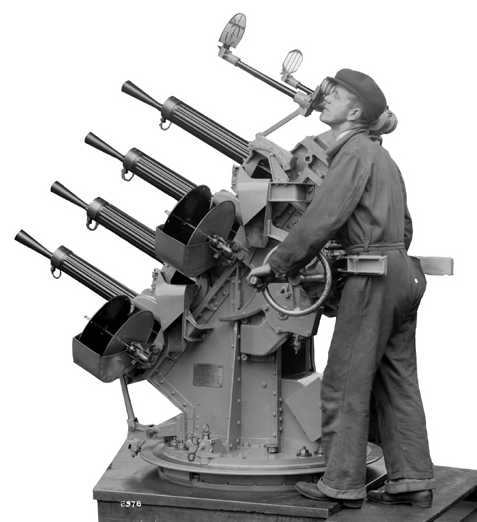
Vickers started production of this gun in 1926, but service introduction on British ships does not seem to have taken place prior to 1932. This weapon was used on almost all British warships during World War II, many in quad mounts like the ones shown below.
This was a recoil-operated, water-cooled gun with link-belt ammunition feed and was significantly less powerful than the USN's 0.50" (12.7 mm) Browning M2 BMG. Like the US and most other nations, the British found small-caliber machine guns like these to be ineffective against modern aircraft. Nonetheless, this weapon was still produced in large numbers during the war with an overall total of 12,500 being built.
A few guns were exported to Japan during the late 1930s where they were designated as the 12 mm/62 "BI" Type (also known as the "HI" Type). The Japanese guns were mostly replaced by the start of the Pacific War by the superior 13 mm Type 93 and 25 mm Type 96 Hotchkiss guns.
China purchased 19 British guns pre-war.
Actual bore length was 62.5 calibers.
Unless otherwise noted, the data below is for British weapons.| Designation 1 | 0.5"/62 (12.7 mm) Mark III
Suffixes:
|
|---|---|
| Ship Class Used On | Britain: Almost all warships in World War II
Japan: N/A |
| Date Of Design | 1926 |
| Date In Service | 1926 |
| Gun Weight | 56 lbs. [62 lbs. with filled cooling jacket] (25.4 kg [28.1 kg]) |
| Gun Length oa | about 35 in (89 cm) |
| Bore Length | 31.25 in (79.4 cm) |
| Rifling Length | N/A |
| Grooves | N/A |
| Lands | N/A |
| Twist | N/A |
| Chamber Volume | N/A |
| Rate Of Fire 2 | 600 to 700 rounds per minute cyclic
450 rounds per minute cyclic when used with a delay pawl 150 to 200 rounds per minute practical |
- ^The guns for single and twin mounts were similar to those for the quad mounts but had shoulder rests.
- ^Each ammunition drum held 200 rounds, which was enough for about twenty seconds of firing. The four ammunition drums on the quad mounting could be replaced within thirty seconds by a well-trained crew.
| Type | Fixed |
|---|---|
| Weight of Complete Round | 2.9 oz (0.08 kg) |
| Projectile Types and Weights 1a | Ball: 580 gr., 1.326 oz (37.6 gm) |
| Bursting Charge | Solid bullet |
| Projectile Length | N/A |
| Propellant Charge | Ball: 142gr., 0.324 oz. (9.2 gm) Cordite 7/2 |
| Muzzle Velocity | 2,520 fps (768 mps) |
| Working Pressure | N/A |
| Approximate Barrel Life | N/A |
| Magazine capacity per gun | About 2,500 rounds |
- ^Bullets were also produced in AP, SAP, SAP-T and Incendiary.
- Ammunition was in a 200-round belt carried in a drum. Each loaded drum weighed 60 lbs. (27.2 kg).
| Elevation | Distance |
|---|---|
| Effective Range | 800 yards (730 m) |
| Maximum Range | about 5,000 yards (4,570 m) |
Pre-war calculations determined that a ten second burst with a quad mount, equivalent to about 400-450 rounds, could expect 40 rounds to hit a target. However, this analysis assumed that the target area was entirely within the pattern of spread for the duration of the burst, an assumption that meant that both the layer and the trainer needed to perfectly judge the approach speed of the attacking aircraft and then constantly adjusting - by hand - their aiming during those ten seconds, regardless of how their ship rolled, pitched and yawed during that time.
| Designation | Single Mountings
Mark VI Also some Scarf Ring types Twin Mountings
Quad Mountings 4b 5b:
6b |
|---|---|
| Weight | Mark I: 1,605 lbs. (728 kg)
Mark I*: 2,200 lbs. (998 kg) Mark II: 2,888 lbs. (1,310 kg) Mark III: 2,580 lbs. (1,170 kg) Mark IV: 1,692 lbs. (772 kg) Mark V: 1,041 lbs. (472 kg) Mark VC: N/A |
| Elevation | Mark I and Mark I**: -10 / +70
Mark II, Mark II** and Mark III: -10 / +80 degrees Mark IV: -10 / +70 Mark V and Mark VC: -10 / +70 |
| Elevation Rate | All except Marks V and VC: Manually operated, only
Marks V and VC: 50 degrees per second |
| Train | 360 degrees |
| Train Rate | All except Marks V and VC: Manually operated, only
Marks V and VC: 72 degree/s per second |
| Gun recoil | 1.25 in (3.2 cm) |
- ^The twin Mark IV mounting was used mainly on MLs, MMS, some Bangor class minesweepers, and trawlers.
- ^The Mark V twin turret was a light weight unit intended for MTBs but was also used on a few LCS(M), destroyers and corvettes. It was hydraulically powered and the belt feed ran through hollow inner trunnions. The hydraulic pump was located off the mounting and this was powered from the engine of the MTB.
- ^The Mark VC was an American-produced mounting and could also be used for the US 0.50 in (1.27 cm) Browning M2 MG.
- ^Large ships usually had four quad mountings, but HMS Ark Royal had eight. Cruisers had two to four and destroyers had two.
- ^The quad mounting had its barrels slightly misaligned from each other in order to give a "scatter" effect.
- ^Early quad mountings had a single gunner that controlled train by a 'U' bracket around his hips as can be seen in the photograph above and controlled elevation by a geared handwheel. Later quad mountings, as per the photograph of a destroyer mounting below, had both a trainer and a layer crewmen who used geared handwheels to control elevation and training.
- ^7.17.27.3The Mark III mounting had a new type of base plate that was more robust and of larger diameter than the previous types. As opportunity offered, the older Mark I and Mark II mountings were modified to bring them into line with the Mark III. These modified mounts were then designated as Mark I* and Mark II* to distinguish them from unmodified mounts.
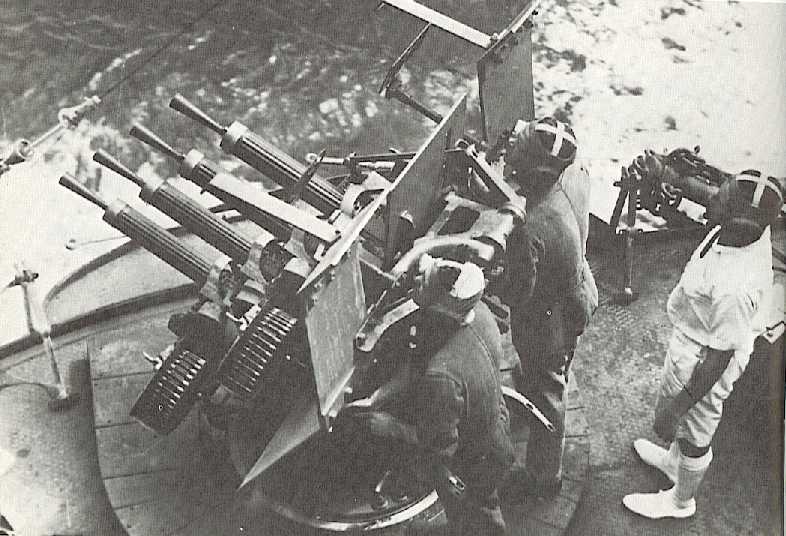
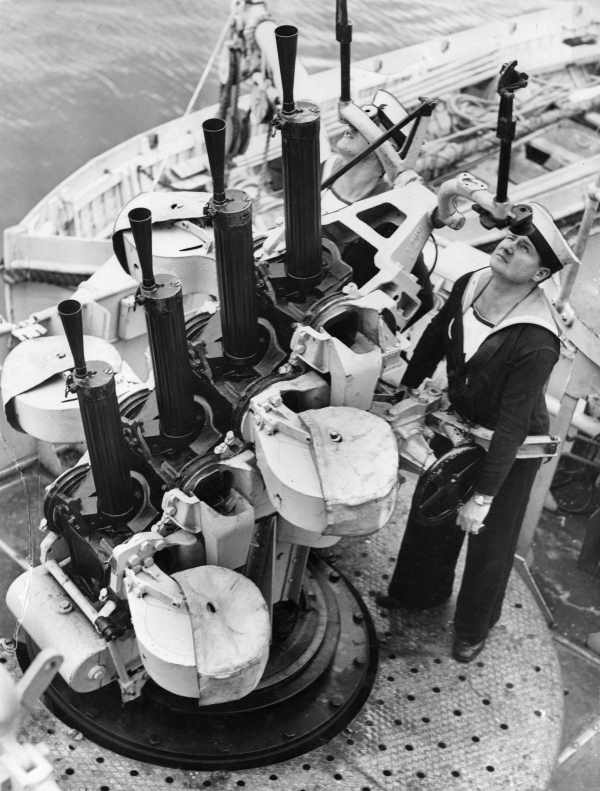
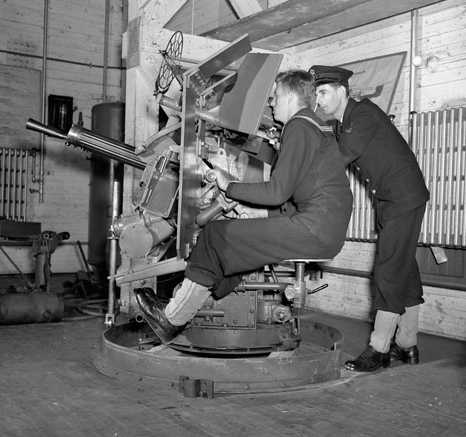
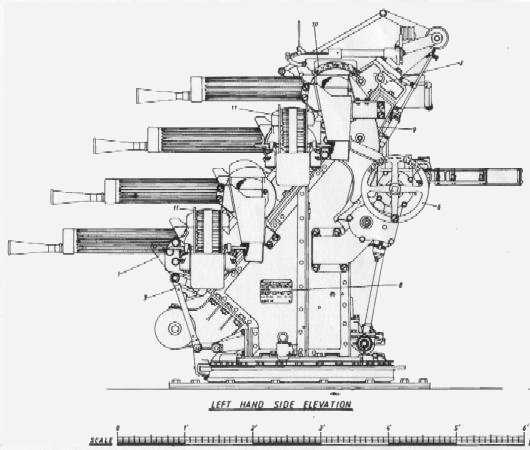
"Naval Weapons of World War Two" by John Campbell
"Destroyer Weapons of World War 2" by Peter Hodges and Norman Friedman
"Japanese Cruisers of the Pacific War" by Eric Lacroix and Linton Wells II
"British Battleships of World War Two" by Alan Raven and John Roberts
"Anatomy of the Ship: The Battlecruiser Hood" by John Roberts
---
The Vickers Machine Gun
---
Special help by John Lambert and Anthony G. Williams
07 March 2007 - Benchmark
27 January 2010 - Added picture of single gun
12 February 2012 - Updated to latest template
16 June 2012 - Added picture of HMAS Perth
29 November 2015 - Changed Vickers Photographic Archive links to point at Wayback Archive
16 October 2020 - Updated to HTML 5 format, reorganized notes, added propellant information
06 January 2022 - Added mounting note about crewmen
02 October 2022 - Minor changes for clarity
